Effects of fermented protein feed on the growth performance of pond-raised crab
Jiying Yu, Jiayi Yu, Xianming Chn, Xin Zhou, Yunxia Cai,f, Huiyi Cai, Pishi Yan
a College of Animal Science and Technology, Nanjing Agricultural University, Nanjing, 210095, China
b National Engineering Research Center of Biological Feed, Beijing, 100081, China
c Beijing Jiabowen Bio-feed Science & Technology Co. Ltd, Beijing, 102211, China
d Gaochun County Agricultural Bureau, Nanjing, 211300, China
e Wuxi Fisheries College, Nanjing Agricultural University, Wuxi, 214128, China
f Feed Research Institute, Chinese Academy of Agricultural Sciences, Beijing, 100081, China
A B S T R A C T This study aimed to elucidate the effect of a pellet feed containing fermented proteins on pond-raised Chinese mitten crabs,Eriocheir sinensis in a 7-month crab feeding experiment in Gucheng Lake,Jiangsu province,China.The results showed that fermented protein could significantly increase mean weight gain, crab size and total yield compared with control group. Moreover, the mean weight of male crabs and the number of large-sized male crabs improved over those of the control group. However, feed efficiency ratio did not differ significantly between the two groups. The amino acid content in the muscles of the female crabs of both the groups was higher than that in the muscles of the male crabs.The present study suggests that fermented compound protein may be one kind of potential protein sources for E. sinensis.*Corresponding author. College of Animal Science and Technology, Nanjing Agricultural University, Jiangsu, China.E-mail address: yanps@njau.edu.cn (P. Yan).
Keywords:Chinese mitten crab Fermented compound protein feed Sex Feed efficiency Growth performance Muscle amino acids
Chinese mitten crab, Eriocheir sinensis, is a traditional food in Southeast Asia (Chen, Zhang, & Shrestha, 2007; Wang et al., 2016).Both male and female crabs exhibited an allometric relationship of growth pattern with migratory breeding (Li, Li, Liu, & Silva, 2011).Usually, male crabs yielded more than female crabs (Barrento et al.,2010; Triño, Millamena, & Keenan, 1999). Research experiences of the Equilibrated Biological Aquatic System suggested that trash fish supplemented with corn,wheat,and peas was the common crab biological feed in Jiangsu province, China (Blüm, Andriske, Kreuzberg, &Schreibman, 1995; Kong et al., 2012). However, owing to the decreasing small trash fish resources and the resulting pollution of aquaculture water, the demand to limit the usage of trash fish or high fish meal diet in aquaculture increased remarkably (Azra &Ikhwanuddin, 2016; Gomez, Mori, Okinaka, Nakai, & Park, 2010;Krumme, Wang, & Wang, 2013; Wang et al., 2016; Zeng, Gu, Chen, &Mao, 2013). Consequently, trash fish or high fish meal in farming diet was gradually or partially replaced by plant protein sources (Shapawi,Mustafa, & Ng, 2011; Taher et al., 2017).
Many studies showed that some protein feed was able to partially or completely replace fish meal in aquaculture feed (Azarm & Lee, 2014;Sharawy,Goda,&Hassaan,2016;Yamamoto et al.,2010).Weight gain and specific growth rate of Macrobrachium nipponense were significantly higher in the group fed with 25% replacement level diet than with the group fed with fish meal diet (Ding, Zhang, Ye, Du, & Kong, 2015).Soybean meal can replace up to 40% of the fish meal in the diets of Portunus pelagicus juveniles without reducing their growth(Taher et al.,2017). Meat and bone meal protein may replace up to 50% fish meal protein in feed for gilthead seabream juveniles without compromising growth and feed efficiency (Moutinho, Martínez-Llorens, Tomás-Vidal,Jover-Cerdá, & Oliva-Teles, 2017). Earthworm powder incorporated with fish meal, soybean wastes, and rice bran could be an alternative for satisfying the diet requirement of African catfish fingerlings(Hamid,Abdullah,Zakaria,Yusof,&Abdullah,2016).However,the unbalanced amino acid composition and anti-nutritional components in plant feed may be major factors limiting its use(Cai et al.,2014).Fermentation is a method of reducing the anti-nutritional factor content (Barnes,Brown, Rosentrater, &Sewell, 2012;Sharawy et al.,2016;Taher et al.,2017). The de-oiled soybean meal fermented by lactic acid (Refstie,Sahlström, Bråthen, Baeverfjord, & Krogedal, 2005), Aspergillus spp. or Bacillus spp. (Ding et al., 2015), could partially replace fish meal in diets without affecting aquatic animal production. Fermented soybean meal and squid by-product blend (1:1) could replace 36% fish meal protein in the diet of the Japanese flounder, Paralichthys olivaceus(Azarm & Lee, 2014).Up to 40% fish meal in the diet of juvenile black sea bream, Acanthopagrus schlegelii, could be replaced by fermented soybean meal supplemented with methionine, lysine, and taurine(Kader et al., 2012).
However,studies on the application of fermented compound of land animal and plant proteins in aquaculture are limited. Previous studies in our lab have shown that fatty acid compositions in the edible parts of a crab-the hepatopancreas, gonad, and muscles-differed among male and female crabs fed with small trash fish and pellet feed (Yu & Yan,2015). Therefore, we studied an alternative feeding method. The objectives of the study were to (1) reduce the use of trash fish in crab farming, (2) measure crab growth performance, and (3) assess the biochemical changes in the edible parts of crabs.
1. Materials and methods
1.1. Experimental design and crab culture
From February to November 2009, six similar crab-intensive ponds with a water area of 0.67 hm2were chosen for Chinese mitten crabs in Gaochun County near Gucheng Lake in Jiangsu Province (Yu & Yan,2015). The conditions and environments of the ponds were similar,including pond age,pond depth,larvae amount,grass species,fertilizer,and other farming parameters. A single-factor comparison model was adopted with three replicates for each group.
In mid-February,young crabs were put into six ponds with a density of 45.48 kg/pond; i.e., approximately 6000 crabs/pond. In the meantime, submerged macrophytes, such as Hydrilla verticillata and Elodea nuttallii, were planted. Snails (mostly Margarita), freshwater shrimps,Macrobrachium rosenbergii, and mandarin fish (Siniperca chuatsi), were intercropped. Other pond conditions, such as water exchange systems,were similar.The crabs were fed at approximately 3%-5%of their body weight daily,with 30%-40%provided in the morning and 60%-70%in the evening.The feed was intended to be consumed within half an hour,adjusted according to weather conditions and residual feed from the last feeding event. The feed consumption was measured by recording the feeding amount daily during the trial.
1.2. Diets and chemical analysis
In the control group, the crabs were fed with small trash fish, pea and wheat grain (STF), whereas the experimental group was fed with small trash fish and formulated pellet feed (FPF) (Table 1). The trash fish comprised Decapterus maruadsi and Johnius grypotus. The FPF contained fermented compound protein feed (FCPF) (Table 2), which was prepared from dehulled soybean meal, deoiled poultry bowel, cottonseed meal, and earthworm meal fermented with Bacillus subtilis CICC23584, Candida utilis CICC31430, and Lactobacillus plantarum CICC22696 using a two-step, high- and low-temperature solid fermentation process. The final dried FCPF had 90.7% dry matter, which included 53% crude proteins and 3.3% crude fat.
The analysis shows that there was difference between two diets.The ether extract and crude ash of STF were significantly higher than those of FPF (P <0.05) whereas the crude protein and crude fiber were lower in STF than in FPF (P <0.05). Total energy (calculated) were not significantly different, whereas the ratio of protein/total energy of STF was significantly lower than that of FPF (P <0.01; Table 1).
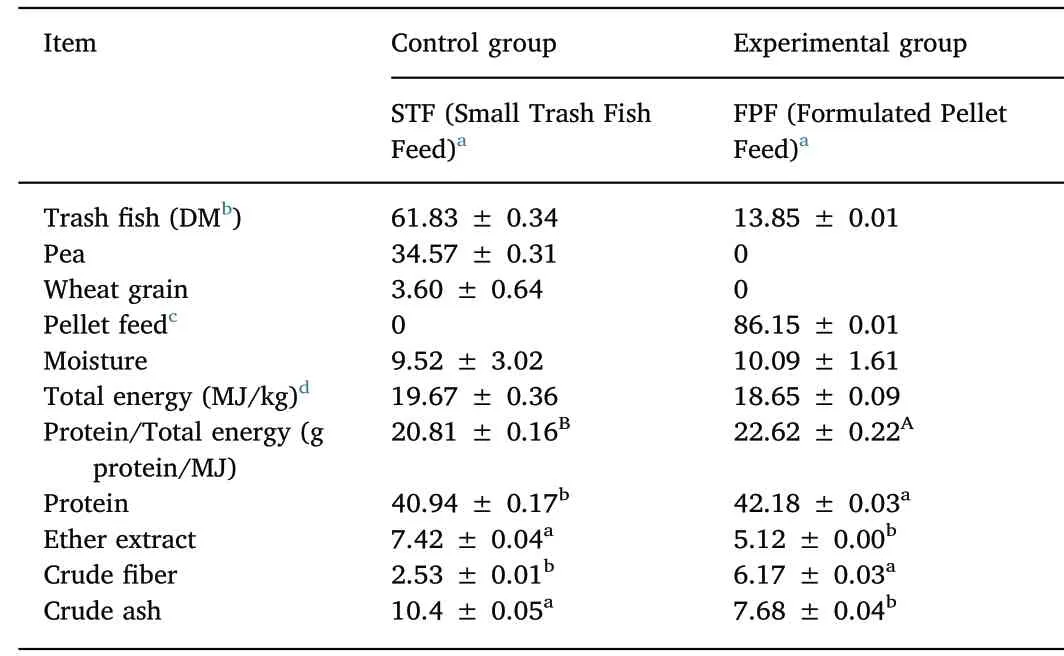
Table 1Composition and chemical analysis of the diets used (n=3).
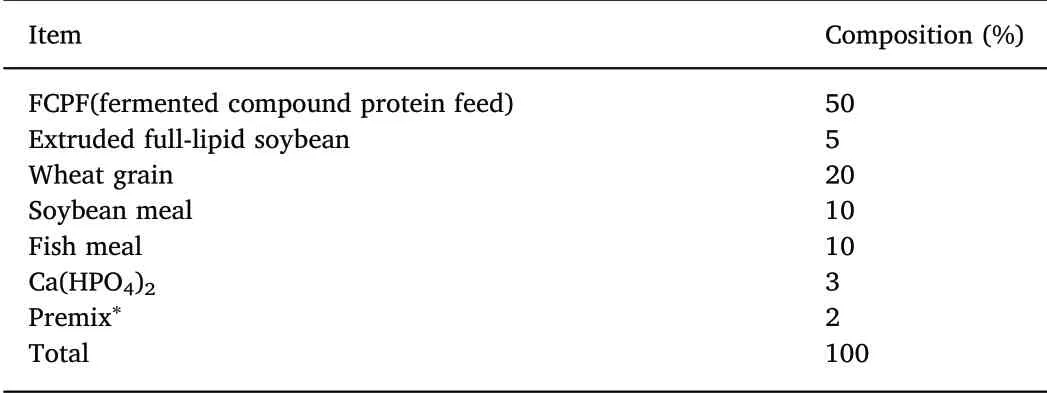
Table 2Composition of pellet feed.
1.3. Growth performance and feed efficiency
In early April,120 healthy crabs were randomly selected from each pond and weighed (9.1 g/crab, 6000 crabs/0.67 hm2) to measure the initial weight(Wstart)of the crabs.From September to November,all the crabs,which met the required weight for marketing were captured and weighed (Wend). The number, size, and weight of the captured crabs were recorded as end value (trial days, 210 days). The growth performance and feed efficiency the crabs were calculated using the following formulae:
Specific growth rate (SGR) (%/day)=[ln(Wend) - ln(Wstart)]∕trial
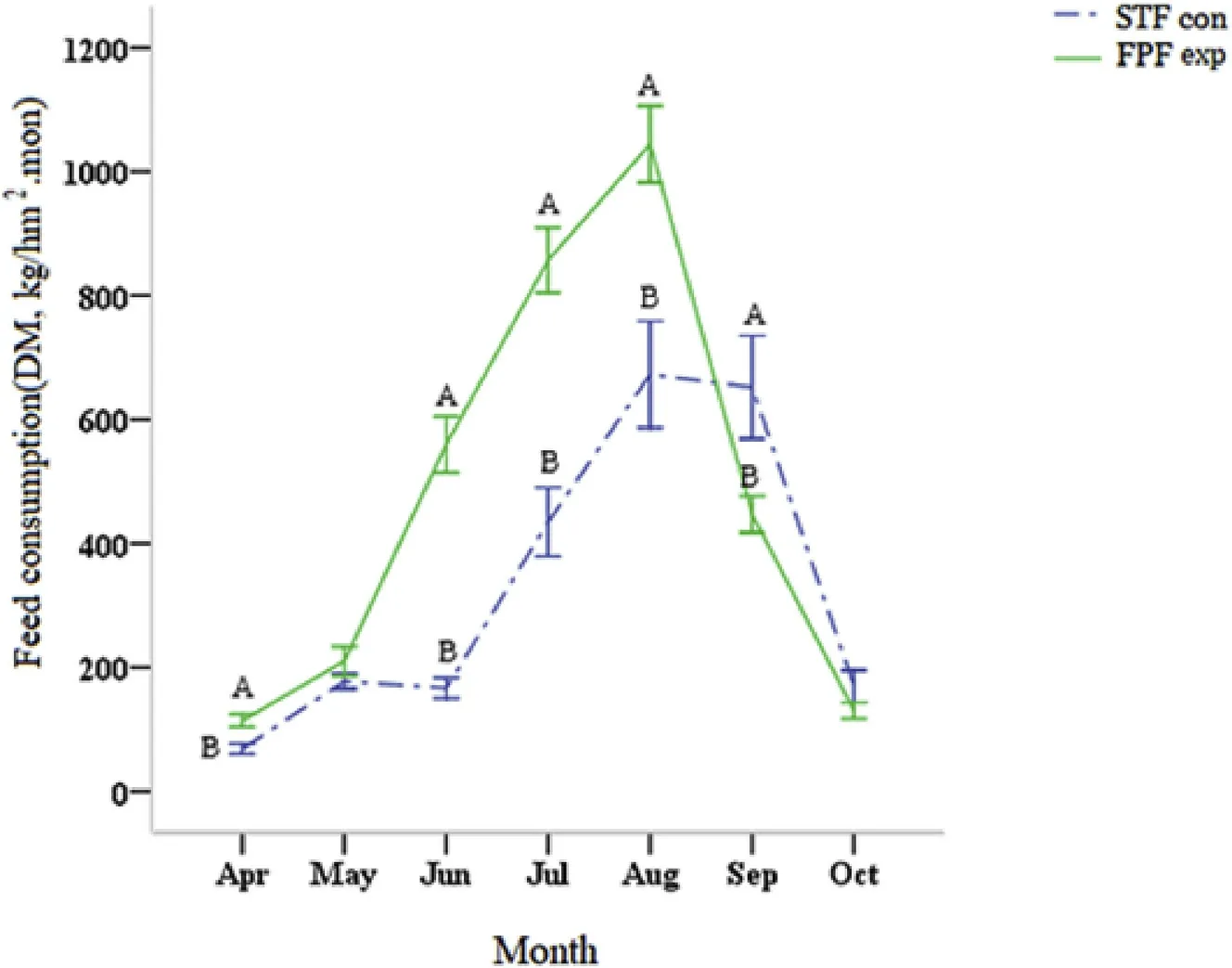
Fig. 1. Feed consumption in two groups (n=3, mean ± SE, kg/hm2·month).Different capital letters indicate extremely significant differences (P <0.01).
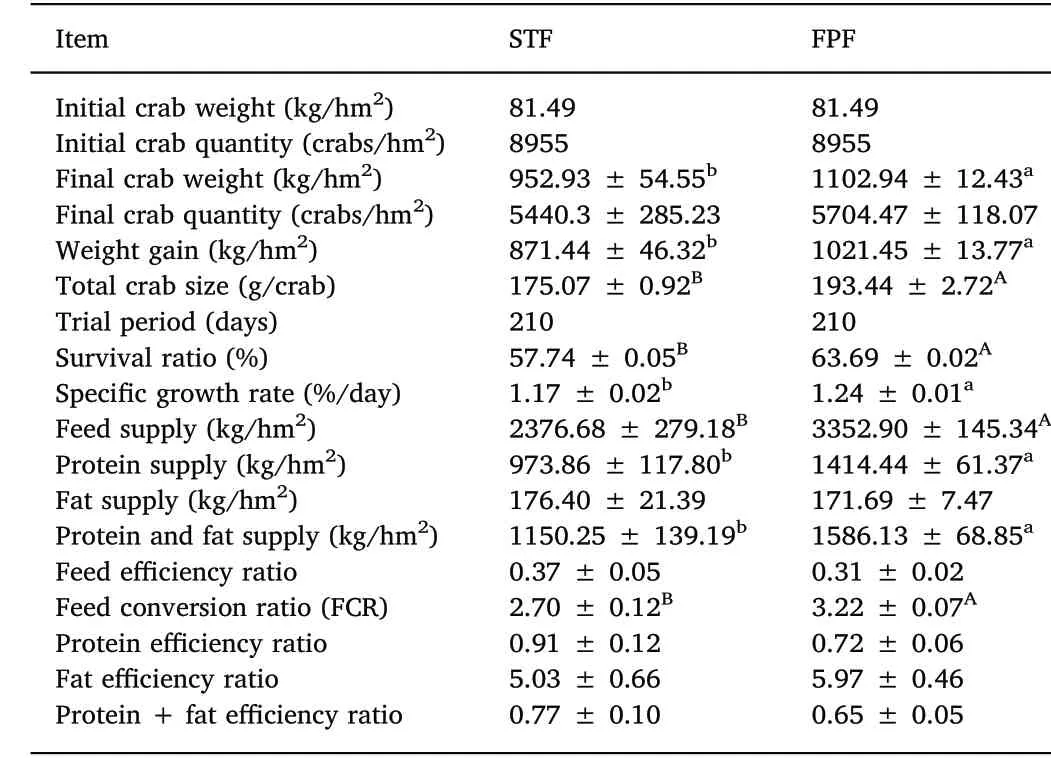
Table 3Crab production and feed efficiency of two groups (n=3, mean ± SE).
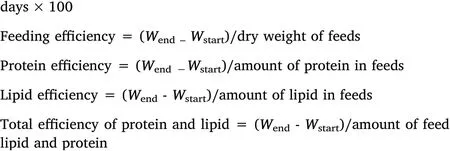
1.4. Biological properties of crabs
In mid-October,six male and six female crabs of the same size were sampled from each treatment group and weighed. A total of 24 crabs were transported live to the laboratory, and their edible parts (hepatopancreas,gonads,meat from claws,legs,and abdomen muscles)were manually separated and weighed. The samples were stored at -20°C until further use. The hepatosomatic index (HSI) and gonadosomatic index (GSI) were calculated using the following formula.HSI=hepatopancreas weight∕body weight×100 GSI=gonadosomatic weight∕body weight×100
1.5. Biochemical analysis
The water content of the crabs was determined by drying the sample in an oven at 105°C until a constant weight was obtained. Crude protein content was determined by the Kjeldahl method, and a conversion factor of 6.25 was used to convert total nitrogen into crude protein.Ether extract (EE) for crude fat was determined by the Soxhlet extraction method. HPLC-Agilent 1100 (Agilent Technologies, Calif., USA)was used in amino acid test.The amino acid scores of the edible parts of the crabs were calculated using the following formula (Chen et al.,2007):
Amino acid score=amino acid content∕reference amino acid pattern×100
1.6. Data analysis
SPSS 16.0 (SPSS, Inc., Chicago, IL, USA) was used to perform independent samples t-tests of the continuous data or one-way analysis of variance. Two-factor analysis of variance for the effects of sex (♂, ♀)and feed(STF,FPF)were conducted to analyze the amino acid profile in the hepatopancreas and muscles. The results are expressed as means ± standard error (mean ± SE). P <0.05 was considered statistically significant, whereas P <0.01 was considered extremely significant.
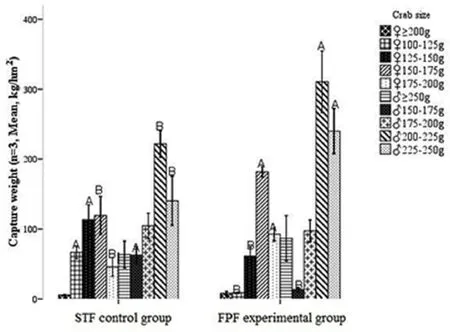
Fig. 2. Weight of the crabs at capture in the two experimental groups.Note: Different capital letters indicate extremely significant difference (P <0.01).

Table 4Crab production of two groups (n=3, mean ± SE).

Table 5Crab sample specifications of two groups (n=6, mean ± SE).
2. Results
2.1. Feed consumption and feed efficiency
The feed consumption in June, July, and August, of the FPF group was significantly higher than that of the STF group(P <0.01)(Fig.1).The fat supply from April to October of the FPF group did not differ significantly between the two group, but the protein supply and protein + fat supply were significantly higher than that of the STF group(Table 3). The results showed that the feeding patterns and nutritional composition of FPF and STF diet greatly affected the feed consumption and nutrient supply in crab farming. However,feed efficiency ratio did not differ significantly between the two diets (Table 3).
2.2. Crab output and production performance
Mature crabs were captured from late-September to mid-November.The survival ratio, total yield, and average size of the crabs of the FPF group were higher than those of the STF group (P <0.01). The mean crab weight (P <0.05)was significantly higher in the FPF group than in the STF group (Table 3). Further analysis of the specifications showed that the quantity and average size of large female crabs(>150 g each) and large male crabs (>200 g each) of the FPF group were significantly higher than those of the STF group, whereas the quantity and size of medium female crabs (100-150 g each) and male crabs (150-175 g each) were significantly lower than those of the STF group (P <0.01) (Fig. 2). Other parameters were not significantly different between the two groups. The results suggested that the experimental diet might improve the male crab survival ratio,the average weight of male crabs, the number of large-sized male crabs and total crab harvest quantity.

Table 6Amino acid content and score of crab hepatopancreas and muscle of two groups (n=6).
The crab production performance of six ponds was compared using two-factor analysis (Table 4). The crab production and average size of the FPF group was significantly higher than those of the STF group(P <0.05 and P <0.01, respectively). The production and average size of male crabs were higher than those of the female crabs(P <0.01). The capture quantity and production showed a significant interactive diet×sex effect, the production and average size of the male crabs were higher than those of the female crabs (P <0.01)(Table 4).Therefore,pond output and average size were affected by sex and diet, whereas FPF might improve the male crab production performance preferably.
2.3. Crab biochemical and biological properties
Except for the total amino acid (TAA) content in hepatopancreas and muscle, no significant difference was noted between the two diets.In addition,except for water and TAA content in hepatopancreas,there was no diet×sex effect, but an effect of sex was detected. The mean weight of the male crabs was significantly higher and GSI was significantly lower than those of the female crabs (P <0.01). The hepatopancreas weight and water content of male crabs were higher, and muscle TAA content was lower than those of female crabs (P <0.05).No significant difference was observed in the other parameters between diets, sexes, and diet×sex effects.
As compared with the published amino acid pattern (Chen et al.,2007), scores of all the eight amino acids were >100 in both the groups, both male and female crabs, and both the hepatopancreas and muscle. The total scores in hepatopancreas were higher than those in muscles, but no significant difference was found between the diets or the sexes(Table 6).These findings suggest that the amino acids in crab hepatopancreas and muscle for both diets and sexes are of high quality.
3. Discussion
3.1. Effect of protein source on feed efficiency
Fermentation decreased the anti-nutritional content of soybean meal and improved nutritional value, availability, and palatability(Refstie et al.,2005;Sharawy et al.,2016).The use of a suitable level of fermented soybean meal for juvenile black sea bream, Acanthopagrus schlegeli,resulted in significantly higher daily feed intake,daily protein intake, feed and protein efficiency ratios, HSI and visceral somatic index, and muscles amino acid content than a diet rich in fish meal(Azarm & Lee, 2014). A high-protein diet could increase fish protein deposition (Meyer-Burgdorff& Rosenow, 1995), whereas a plant protein diet was shown to increase the protein content of fish muscles(Francesco et al., 2004).
The results of the present study are consistent with those of Azarm and Lee (2014), Meyer-Burgdorffand Rosenow (1995). The factor varying between the experimental and the control groups was the highprotein diet with fermented protein feed, which might be due to the increase in feed consumption.
3.2. Sex-based difference in crab production
Male brown crabs, Cancer pagurus, yielded more than the female ones did (Barrento et al., 2010). Male mud crabs, Scylla sp., gained more weight than females (Triño et al., 1999). Monosex culture has become a common practice in fish aquaculture (Aflalo et al., 2012).Culturing all-male giant freshwater prawn, Macrobrachium rosenbergii,presented a promising avenue for increasing yield (Aflalo et al., 2014).Triploid fish had a lower gonad weights and higher apparent net protein utilization than diploids(Pechsiri&Yakupitiyage,2005).However,female prawns in monosex cultures grew faster than the males and male prawns from mixed-sex tanks, and feed intake and weight increment per molt were higher (Hansford & Hewitt, 1994).
The results of the present study are similar to those of Barrento et al., 2010 and Triño et al. (1999). This study reported that the production of male crabs fed with FPF-Fermented compound protein feed improved. More profit would be earned from improved male Chinese mitten crab culture. However, the diets used were not isoproteic or isoenergetic, and the results may be caused by the increase in feed consumption and higher ratio of protein/energy. It might be an advantage for commercial crab culture, but these findings need to be validated by further research.
3.3. Sex-based difference in amino acid content
Shellfish meat is generally considered highly nutritious due to its amino acids contents (Abdel-Salam, 2014; Chen et al., 2007; Vilasoa-Martínez et al., 2007). The biochemical composition of Cancer pagurus varied among tissues and between sexes (Barrento et al., 2010). The amino acid content was found to be higher in the muscle of female blue swimmer crabs (Portunus pelagicus) (Wu et al., 2010), female prawns(Macrobrachium rosenbergii) (Bhavan et al., 2010), and female Chinese mitten crab (Tao et al., 2018), than those of the males. Australian red claw crayfish fed with commercial diet, moisture content of tail meat,and protein of male and female were not significantly different(Thompson et al., 2004).Whole-body protein content was significantly lower in Pacific white shrimp fed with an improved soybean meal replacing two-thirds of the fish meal in the diet, the two diets being isonitrogenous and isolipidic (Hulefeld et al., 2018). However, there has been little data on how the amino acid content of Chinese mitten crab muscles affected by fermented protein feed.
The present study was consistent with the findings of Wu et al.(2010)and Tao et al.(2018).It might be owing to the differences in sex development and energy requirements for maintenance during the adult stage (Bhavan et al., 2010).
This study indicated that fermented protein feed partially replacing trash fish improved the amino acid content in the muscles of both male and female crabs.The conclusion might provide the basis for to further detailed studies on the mechanisms that affect crab nutrition,including the effects of sex, diet, and diet×sex effect.
4. Conclusions
Crab pond output and average size were affected by sex and diet.Partial substitution of trash fish by fermented compound protein feed in crab diet increased crab harvest quantity, male crabs yield and the number of large-sized male crabs. The amino acid content in crab muscles were different between sex, female crabs of both the groups was higher than that of the male crabs.
Conflicts of interest
The authors declare that they have no conflict of interest.
Acknowledgments
This study was supported by Science and Technology Planning Project of Tianjin City, China (2018YFD0500603).
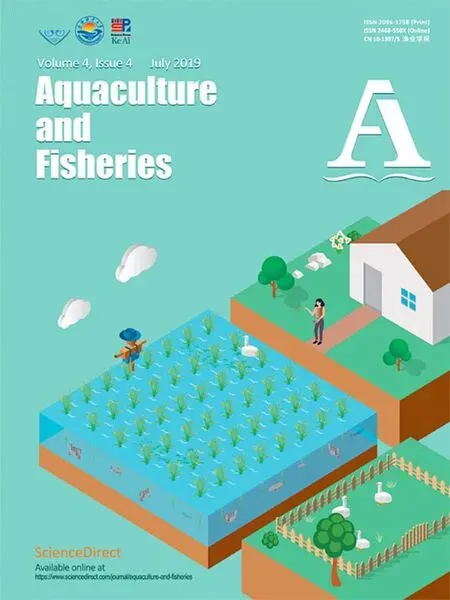 Aquaculture and Fisheries2019年4期
Aquaculture and Fisheries2019年4期
- Aquaculture and Fisheries的其它文章
- Natural versus synthetic anesthetic for transport of live fish: A review
- Methane and nitrous oxide emissions in rice-crab culture systems of northeast China
- Increased pCO2 changes the lipid production in important aquacultural feedstock algae Isochrysis galbana, but not in Tetraselmis suecica
- Assessing recent gradual upsurge of marine captured Hilsa stock (Tenualosa ilisha) in Bangladesh
- Comparative age and growth of Uroteuthis chinensis and Uroteuthis edulis from China Seas based on statolith
